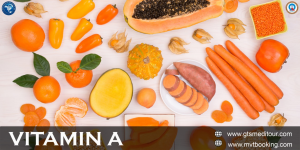DEFINITION
Vitamins are organic compounds,required to the body in small amounts,so categorized under micro nutrients.Also classified under protective and regulatory food.They do not yield energy,but help the body to utilize other nutrients
CLASSIFICATION
- Fat soluble – Vitamin A,D,E &K
- water soluble – Vitamin B & C
VITAMIN A
- It acts as a regulator of cell and tissue growth and differentiation
- it is a group of unsaturated nutritional organic compounds that includes retinol,retinal and several pro vitamin A carotenoids
- it is important for growth and development for the maintenance of the immune system
- for good vision
- immunity-susceptibility to infection and lowered immune response is found in deficiency of vitamin A
- Vitamin A is needed by the retina of the eye in the form of retinal ,which combines with protein opsin to form rhodopsin,the light-absorbing molecule necessary for both low light and color vision
- it also functions in a very different role as retinoic acid,which is an important hormone like growth factor for epithelial and other cells
- Vitamin A covers both vitamin and pro vitamins
- Vitamin A retinol is from animal source
- Pro vitamin of vitamin A is beta-carotene.It is converted into retinol by intestinal mucosa
SOURCES
- Animal origin- Liver,eggs,butter,cheese,whole milk,fish and meat
- Plant origin – green leafy vegetables,spinach,yellow fruits,papaya,mango,pumpkin,roots like carrot
- Artificially fortified foods-milk, vanaspathi,margarine
STORAGE
Stored in the liver in the form of retinol palmitate.The store is sufficient to meet the needs for 6-9 months
DEFICIENCY
Predominantly ocular manifestations,less commonly extra ocular manifestations also found
XEROPHTHALMIA
it includes all ocular manifestations of Vitamin A deficiency from night blindness to keratomalacia
- Night blindness
- Conjunctival xerosis
- Bitots spots
- Corneal xerosis
- keratomalacia
Night blindness:
It is beginning stage of Vitamin A deficiency with inability to see in the dim light
Conjuctival xerosis:
First clinical sign of Vitamin A deficiency ,conjunctiva is dry and non wettable. Instead of smooth and shining conjunctiva appears muddy and wrinkled
Bitots spots:
Triangular pearly white or yellowish foamy spots on bulbar conjunctiva on either side of cornea ,usually bilateral is known as bitots spot
Corneal xerosis:
Serious condition,cornea appears dull,dry,non wettable and eventually opaque.Severe deficiency leads to corneal ulceration.It may heal with scars which are opaque
Keratomlacia:
Liquefaction of cornea takes place ,cornea may become soft & may burst open.The process is rapid ,eye collapses and vision is lost
EXTRA OCULAR MANIFESTATIONS
They consist of follicular hyperkeratosis, anorexia and growth retardation
MEASURES FOR PREVENTION
- Improvement of diet ,regular and sufficient intake of vitamin rich food
- By preventing contributory factors Ex.PEM,respiratory infection,diarrhea,measles
- Prophylactic dose of vitamins A-single massive dose of retinol palmitate orally,to all preschool children(1-6 yrs)once in 6 months is advocated, 1-6 yr -2,00,000 IU of retinol palmitte, 6 months -1 yrs -1,00,000 IU of retinol palmitate
For getting opinion from our network of hospitals visit mvtbooking.com or sent a email to query@gtsmeditour.com


Post a comment